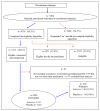Trials and tribulations of recruiting 2,000 older women onto a clinical trial investigating falls and fractures: Vital D study
- PMID: 19930724
- PMCID: PMC2790455
- DOI: 10.1186/1471-2288-9-78
Trials and tribulations of recruiting 2,000 older women onto a clinical trial investigating falls and fractures: Vital D study
Abstract
Background: Randomised, placebo-controlled trials are needed to provide evidence demonstrating safe, effective interventions that reduce falls and fractures in the elderly. The quality of a clinical trial is dependent on successful recruitment of the target participant group. This paper documents the successes and failures of recruiting over 2,000 women aged at least 70 years and at higher risk of falls or fractures onto a placebo-controlled trial of six years duration. The characteristics of study participants at baseline are also described for this study.
Methods: The Vital D Study recruited older women identified at high risk of fracture through the use of an eligibility algorithm, adapted from identified risk factors for hip fracture. Participants were randomised to orally receive either 500,000 IU vitamin D3 (cholecalciferol) or placebo every autumn for five consecutive years. A variety of recruitment strategies were employed to attract potential participants.
Results: Of the 2,317 participants randomised onto the study, 74% (n = 1716/2317) were consented onto the study in the last five months of recruiting. This was largely due to the success of a targeted mail-out. Prior to this only 541 women were consented in the 18 months of recruiting. A total of 70% of all participants were recruited as a result of targeted mail-out. The response rate from the letters increased from 2 to 7% following revision of the material by a public relations company. Participant demographic or risk factor profile did not differ between those recruited by targeted mail-outs compared with other methods.
Conclusion: The most successful recruitment strategy was the targeted mail-out and the response rate was no higher in the local region where the study had extensive exposure through other recruiting strategies. The strategies that were labour-intensive and did not result in successful recruitment include the activities directed towards the GP medical centres. Comprehensive recruitment programs employ overlapping strategies simultaneously with ongoing assessment of recruitment rates. In our experience, and others direct mail-outs work best although rights to privacy must be respected.
Trial registration: ISRCTN83409867 and ACTR12605000658617.
Figures
References
-
- AIHW. Australia's Health 2008 - Australian Institute of Health and Welfare. 2008. http://www.aihw.gov.au/publications/aus/ah08/ah08-c05.pdf
-
- Lord S, Sherrington C, Menz H, Close J. Falls in Older People: Risk factors and strategies for prevention. Cambridge, UK: Cambridge University Press; 2007.
-
- Cumming R. Injury epidemiology and older people: Counting and analysing data on falls. Australasian Epidem. 2000;7:10–12.
Publication types
MeSH terms
Substances
Associated data
LinkOut - more resources
Full Text Sources
Medical


